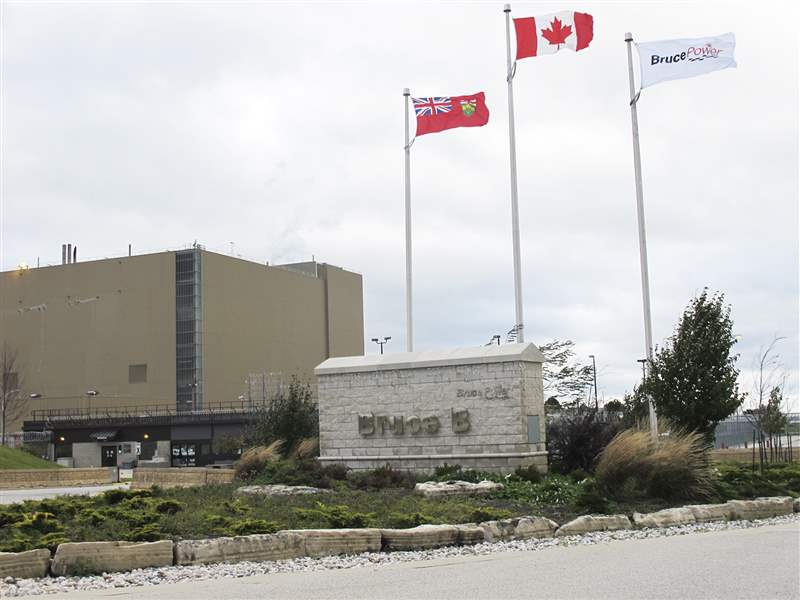
Local mayors oppose proposed Canadian nuclear waste plan
12/8/2017
Flags wave at one of the nuclear reactor units at the Bruce Power complex near Kincardine, Ontario in 2013. Ontario Power Generation is asking the Canadian government for permission to permanently store low- and intermediate-level radioactive waste in an underground chamber that would be constructed on the Bruce Power property.
ASSOCIATED PRESS
Toledo Mayor Paula Hicks-Hudson, Oregon Mayor Michael Seferian, Port Clinton Mayor Hugh Wheeler, Jr., and Sandusky, Mich. Mayor Thomas Lukshaitis are among 104 elected officials who signed a new letter imploring the Trudeau administration to stop Ontario Power Generation from burying low and intermediate-level nuclear waste a mile from Lake Huron.
OBJECTOntario Power Generation — Canada’s largest utility — wants to build a deep underground bunker on the site of its massive eight-reactor Bruce nuclear power complex in Kincardine, Ont., about a four-hour drive north of Toledo. The radioactive waste, much of which is now being stored in above-ground vaults, would be sent down a half-mile shaft into a permanent structure called a Deep Geologic Repository, or DGR.
The proposal has garnered controversy because of its proximity to the Great Lakes, the primary source of drinking water for 30 million Americans and 10 million Canadians.
Opponents of the plan were hoping Prime Minister Justin Trudeau, a member of Canada’s Liberal Party, would reject it immediately. Mr. Trudeau replaced former Prime Minister Stephen Harper, a member of the Conservative Party of Canada who was generally supportive of the project. But Mr. Trudeau has yet to formally act.
“We are deeply concerned that Ontario Power Generation (OPG) is proposing to bury nuclear waste in close proximity to the Great Lakes,” according to the letter, which also states that officials who signed it find the utility’s decision to remain focused on that site “irresponsible and deeply troubling.”
The utility had said repeatedly it has geologic tests to prove disposal could be done safely there, claiming there’s scientific evidence to show the hard rock there hasn’t shifted for at least 450 million years.
The DGR would cost more than $1 billion to build, the utility has said.
The Bruce nuclear complex is one of the world’s largest, generating 25 percent of Ontario’s electricity and employing about 4,000 people. Their wages and other revenue from the nuclear industry support half of Kincardine’s 12,000 jobs.
Toledo, Oregon, and Port Clinton are among dozens of communities across the basin that have passed some 230 resolutions in opposition to the project.
Thirty-two members of Congress signed a letter of opposition on Nov. 5, 2015, the day after Mr. Trudeau took office, including U.S. Sens. Debbie Stabenow (D., Mich.), Gary Peters (D., Mich.), and Sherrod Brown (D., Ohio), as well as U.S. Reps. Marcy Kaptur (D., Toledo) and Debbie Dingell (D., Dearborn).
Contact Tom Henry at thenry@theblade.com, 419-724-6079, or via Twitter @ecowriterohio.